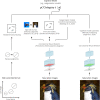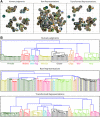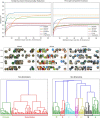From convolutional neural networks to models of higher-level cognition (and back again)
- PMID: 33754368
- PMCID: PMC9292363
- DOI: 10.1111/nyas.14593
From convolutional neural networks to models of higher-level cognition (and back again)
Abstract
The remarkable successes of convolutional neural networks (CNNs) in modern computer vision are by now well known, and they are increasingly being explored as computational models of the human visual system. In this paper, we ask whether CNNs might also provide a basis for modeling higher-level cognition, focusing on the core phenomena of similarity and categorization. The most important advance comes from the ability of CNNs to learn high-dimensional representations of complex naturalistic images, substantially extending the scope of traditional cognitive models that were previously only evaluated with simple artificial stimuli. In all cases, the most successful combinations arise when CNN representations are used with cognitive models that have the capacity to transform them to better fit human behavior. One consequence of these insights is a toolkit for the integration of cognitively motivated constraints back into CNN training paradigms in computer vision and machine learning, and we review cases where this leads to improved performance. A second consequence is a roadmap for how CNNs and cognitive models can be more fully integrated in the future, allowing for flexible end-to-end algorithms that can learn representations from data while still retaining the structured behavior characteristic of human cognition.
Keywords: categorization; cognitive modeling; convolutional neural networks; similarity; vision.
© 2021 New York Academy of Sciences.
Conflict of interest statement
The authors declare no competing interests.
Figures









Similar articles
-
A failure to learn object shape geometry: Implications for convolutional neural networks as plausible models of biological vision.Vision Res. 2021 Dec;189:81-92. doi: 10.1016/j.visres.2021.09.004. Epub 2021 Oct 8. Vision Res. 2021. PMID: 34634753
-
Limits to visual representational correspondence between convolutional neural networks and the human brain.Nat Commun. 2021 Apr 6;12(1):2065. doi: 10.1038/s41467-021-22244-7. Nat Commun. 2021. PMID: 33824315 Free PMC article.
-
Extracting Low-Dimensional Psychological Representations from Convolutional Neural Networks.Cogn Sci. 2023 Jan;47(1):e13226. doi: 10.1111/cogs.13226. Cogn Sci. 2023. PMID: 36617318
-
Beyond the feedforward sweep: feedback computations in the visual cortex.Ann N Y Acad Sci. 2020 Mar;1464(1):222-241. doi: 10.1111/nyas.14320. Epub 2020 Feb 28. Ann N Y Acad Sci. 2020. PMID: 32112444 Free PMC article. Review.
-
Texture and art with deep neural networks.Curr Opin Neurobiol. 2017 Oct;46:178-186. doi: 10.1016/j.conb.2017.08.019. Epub 2017 Sep 18. Curr Opin Neurobiol. 2017. PMID: 28926765 Review.
Cited by
-
Innovative advances in pediatric radiology: computed tomography reconstruction techniques, photon-counting detector computed tomography, and beyond.Pediatr Radiol. 2024 Jan;54(1):1-11. doi: 10.1007/s00247-023-05823-2. Epub 2023 Dec 2. Pediatr Radiol. 2024. PMID: 38041712 Review.
-
Contiguity in perception: origins in cellular associative computations.Trends Neurosci. 2024 Mar;47(3):170-180. doi: 10.1016/j.tins.2024.01.001. Epub 2024 Feb 2. Trends Neurosci. 2024. PMID: 38310022 Free PMC article. Review.
-
Neural Network Model for Perceptual Evaluation of Product Modelling Design Based on Multimodal Image Recognition.Comput Intell Neurosci. 2022 Aug 9;2022:1665021. doi: 10.1155/2022/1665021. eCollection 2022. Comput Intell Neurosci. 2022. Retraction in: Comput Intell Neurosci. 2023 Oct 18;2023:9843472. doi: 10.1155/2023/9843472. PMID: 35983136 Free PMC article. Retracted.
-
Artificial Intelligence and IBD: Where are We Now and Where Will We Be in the Future?Curr Gastroenterol Rep. 2024 May;26(5):137-144. doi: 10.1007/s11894-024-00918-8. Epub 2024 Feb 27. Curr Gastroenterol Rep. 2024. PMID: 38411898 Free PMC article. Review.
-
The Applications of Artificial Intelligence in Cardiovascular Magnetic Resonance-A Comprehensive Review.J Clin Med. 2022 May 19;11(10):2866. doi: 10.3390/jcm11102866. J Clin Med. 2022. PMID: 35628992 Free PMC article. Review.
References
-
- Krizhevsky, A. , Sutskever I. & Hinton G.E.. 2012. ImageNet classification with deep convolutional neural networks. In Advances in Neural Information Processing Systems 1097–1105.
-
- Baxter, J. 2000. A model of inductive bias learning. J. Artif. Intell. Res. 12: 149–198.
-
- Russakovsky, O. et al. 2015. ImageNet large scale visual recognition challenge. Int. J. Comput. Vis. 115: 211–252.
-
- Duta, I.C. , Liu L., Zhu F. & Shao L.. 2020. Pyramidal convolution: rethinking convolutional neural networks for visual recognition. arXiv preprint arXiv:2006.11538.
-
- Lin, T.‐Y. et al. 2014. Microsoft COCO: common objects in context. In European Conference on Computer Vision 740–755.
Publication types
MeSH terms
Grants and funding
LinkOut - more resources
Full Text Sources
Other Literature Sources

